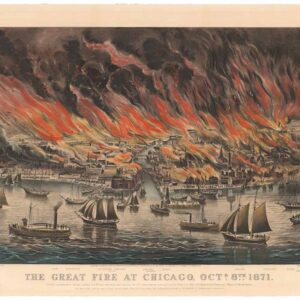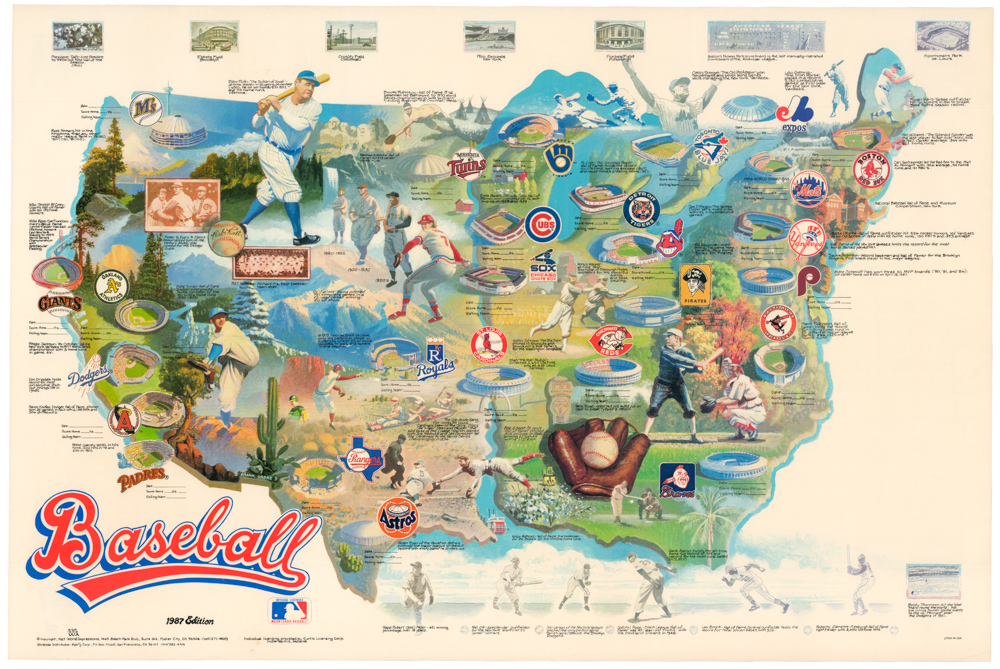A seemingly unrecorded special edition of the Southern Pacific Railway’s large-format promotional map, prepared especially for German-speaking immigrants, with a large side map of Texas
Correct Map of the Railway & Steamship lines operated by the Southern Pacific Company…
Out of stock
Description
This extremely rare and historically important large-format separately-issued map is a special edition from the Southern Pacific Railway’s otherwise rare but well-known promotional map sequence. It depicts their newly-completed system of transcontinental lines and was issued expressly for German-speaking immigrants.
An ephemeral piece, the main map embraces all of the United States and Canada below the 46th parallel (a line running just north of Portland, Oregon; Minneapolis / St. Paul, Minnesota and Montreal, Quebec) and extends all the way south to in embrace Cuba and much of Mexico (extending to a point just south of Mexico City). The map details the main line and spurs of the Southern Pacific Railroad (in bold lines), the Company’s extensive steamship routes, as well as the routes of other major railways (in finer lines). Importantly, in 1883, the Southern Pacific Railway became only the second transcontinental railway in North America (after the Central Pacific Railway), connecting California with New Orleans (and then to other railway systems beyond). The map is exceedingly detailed and labels all stations, as well as all major cities, towns, frontier forts and rivers, while mountains are expressed though hachures.
A large map of Texas, ‘County Map of Texas showing the Atlantic System of the Southern Pacific Company’ adorns the lower right corner of the map, and details Southern Pacific’s ‘Atlantic System’, or its very extensive and important rail system in the Lone Star State. The lower-left corner of the map features detailed inset maps of Los Angeles and San Francisco, Southern Pacific’s two great western terminuses.
The present map is part of the ‘Correct Map’ sequence of promotional route maps printed for the Southern Pacific Railway Company by Poole Bros. of Chicago (a specialist publisher of railway maps). All editions are rare on the market, and we have been able to identify other (exclusively English language) editions issued in 1880, 1884, 1890, 1892, 1893 and 1894. While each edition of the map updates Southern Pacific’s rapidly expanding network of lines, all of them employ the same base template of the main map and Texas map (although they often feature different cartographic insets, text panels and sometimes printing on the verso).
Importantly, however, this particular issue of the map features an interesting twist that distinguishes it from the other known editions. The upper right corner of the present map is dominated by German language text which reads:
Der schnellste, billigste und beste Weg nach Texas, Mexico, Arizona und Californien ist über die Südliche Pacific-Bahn. Passagiere werden ersucht darauf zu achten dass auf ihren Fahrschienen die Bemerkung gesetzt werde: “”Ueber die Südliche Pacific-Eisenbahn.
[Translation: ‘The quickest, cheapest and best way to Texas, Mexico, Arizona and California is on the Southern Pacific Railroad. Passengers are requested to make sure that their itinerary is marked: “”On the Southern Pacific Railroad.’]
This map was intended for the massive German-speaking immigrant market that made up a large percentage of Southern Pacific’s passenger revenue. While printed by Poole Bros. in Chicago, many of these maps would have been immediately exported to Europe to be used as promotional materials for Southern Pacific’s numerous agents and designated booksellers in German-speaking cities in the German Empire, the Austro-Hungarian Empire, Switzerland, as well as in major port cities. The fact that the present example of the map features contemporary booksellers’ stamps from Antwerp and Prague proves that the map soon made its way to Europe. Other examples of this edition of the map would have been given to German-speaking immigrants upon their arrival in America. The map’s clean design and clear labeling would have been an ideal vehicle to orientate someone who was new to America.
The arrival of German-speaking immigrants in America during the period in which this map was made was no niche issue, but rather it had a transformative impact upon the United States. While people of German origin had been one of the largest components of the American population since the late 17th century, the two generations prior to World War I saw the arrival of millions of German-speaking immigrants in the United States, making them by far the largest component of new Americans. Even to this day, German is the largest single ancestry classification of Americans. Economic and political dislocation in Central Europe, as well as religious intolerance (many of the German-speaking immigrants were Jewish) caused many to seek a new life in America. While some already would have heard news about the new country from friends and relatives who had already crossed the Atlantic, many prospective immigrants acquired their first real information on America from promotional pieces, such as the present map, which they received upon visiting travel agencies or designated booksellers in their home countries. In this sense, such ephemera is of great historical importance, as it was on the front line of history, informing the life decisions of real people in real time.
While German-speaking immigrants settled all over America, the West, and Texas in particular, had a particularly strong pull for those seeking a new life free of Old World restrictions. The Southern Pacific Railway, with its strength in Texas and California, was especially well-suited to accommodating these new Americans.
The Southern Pacific Railway & the Present Map in Context
The first transcontinental railway in North America was the Central Pacific Railroad, completed in 1869, it ran from Oakland, California to Omaha, Nebraska. However, it soon became clear that a more southerly transcontinental line was needed, running through the ‘Sun Belt’ from Los Angles to Texas. Such a design was long envisioned, as the United States acquired what became southern Arizona and southwestern New Mexico from Mexico through the Gadsden Purchase (1853), expressly to provide a clear southerly transcontinental all-American route for a future railroad (northern Arizona was considered excessively rugged).
In 1865, a group of investors incorporated the Southern Pacific Railroad Company, initially with the objective of building the first rail link between San Francisco and Los Angeles, although the ambition of eventually constructing a southern transcontinental line was already in mind. In 1868, the company was taken over by the ‘Big Four’ railway barons (Charles Crocker, Leland Stanford, Mark Hopkins, Jr. and C.P. Huntington) who were about the complete the Central Pacific Railroad. This change gave Southern Pacific the muscle to realize its ambitions.
The rail line from San Francisco to Los Angeles was completed in 1876. The following year, with its transcontinental ambitions in mind, Southern Pacific purchased the Houston & Texas Central Railway, the most extensive network in the Lone Star State. Construction of the transcontinental line from Los Angeles eastwards was commenced without delay, and by 1879 the line had reached Tucson, Arizona. In 1881, Southern Pacific acquired both the Texas & New Orleans Railway and the Western Louisiana Railroad, making the Company the king of Texas and Louisiana.
On January 12, 1883, Southern Pacific’s transcontinental line was completed, with uninterrupted track between San Francisco and New Orleans. Importantly, the line was also the first all-weather transcontinental route, as the Central Pacific line was occasionally snowed out in the Rockies. The line became the lifeblood of West Texas, Arizona and New Mexico (being their only fast link to the outside world) and major force in the development of Southern California and Texas in general. Literally hundreds of thousands of new Americans (many German-speaking immigrants) would arrive at their new homes via Southern Pacific trains and steamships.
Southern Pacific soon became the dominant transcontinental railway, as it gained control of the Central Pacific Railroad (although the latter continued to operate as an autonomous corporate unit) in 1885. It also expanded to include lines in Oregon, Mexico and the Mountain states. The present edition of the map is undated, but seems to have been issued in 1885 or 1886. As a point of comparison, the rail system delineated on the main map accords quite closely with that featured on the 1884 edition in the David Rumsey Map Collection, please see link:
http://www.davidrumsey.com/luna/servlet/detail/RUMSEY~8~1~24431~890112:Railway,-steamship-lines-Southern-P
However, the present edition appears to be updated slightly from the 1884 edition to include the uncompleted extension of the Mexican International Railway (a subsidiary of the Southern Pacific) southwestwards past Monclova towards Lerdo (the line from Spofford Jct., Texas to Monclova was competed in early 1884); although this extension is well before its actual completion, as the route of the line was later changed to reach Torreon (completed in 1888), bypassing Lerdo. Moreover, the present edition of the map was issued before the beginning of 1887, when Southern Pacific acquired the Oregon & California Railway (running form Portland down to the Oregon-California boundary), which on this map is shown to not yet be a part of the Southern Pacific system.
The present special edition of the Southern Pacific Railroad map, intended for German-speaking immigrants, is exceptionally rare – we cannot find any references to the map whatsoever. While Poole Bros. probably printed a large number of examples, the survival rate of such ephemeral maps, especially those printed on thin paper without a protective cover is exceptionally low. In addition to being a fascinating artifact of American transport history, the present edition presents an authentic and valuable insight into the American immigrant experience, one of the foundations of the modern republic.
Cartographer(s):
Poole Brothers was a prominent map publishing and printing company based in Chicago, Illinois, known for its extensive production of railroad maps, timetables, and promotional material. Founded by George Amos Poole in the late 19th century, the company became one of the leading map publishers in the United States during a time when rail travel was the primary mode of long-distance transportation.
Condition Description
Backed on Japanese paper. Repaired chip in upper left with small loss to border and a tiny piece of the map in Montana, tiny holes at fold vertices due to wear; contemporary European booksellers’ stamps, blank on verso.
References
This edition is seemingly unrecorded. Cf. David Rumsey Map Collection (online): 1884 ed.: 5234.001; and 1892 ed.: 3139.001.
![[AMERICAN REVOLUTION] Boston, George Washington, Franklin, Philadelphia, Washington, D.C.](https://neatlinemaps.com/wp-content/uploads/2024/05/NL-02090a_thumbnail-300x300.jpg)



